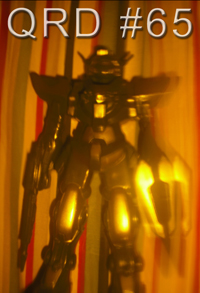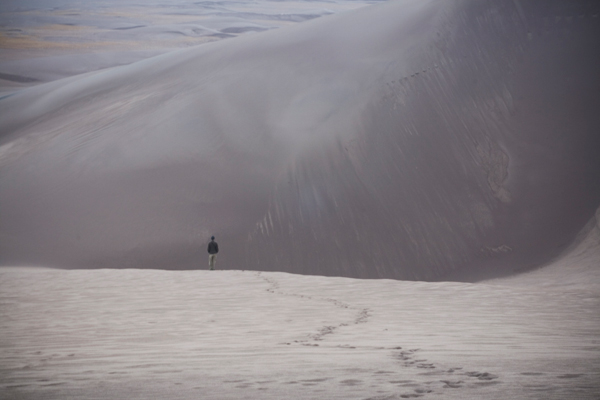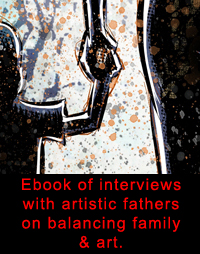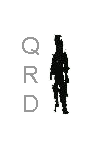
September 2013

Ben Link Collins at The Great Sand Dunes in Colorado, (c) Alan Shero
QRD – Silent Media is really focused on physical objects & always having two artistic disciplines involved. Why are those two things important to you?
Ben – I’ve always enjoyed when artists present their music in a way that deviates from the industry standard. Presumably the artists have put some time & care into the music. They are releasing their work & not just sharing with friends & family because they feel that their efforts are worth a broader audience’s time. So when these unique & important works are presented to the public eye, it’s simply anticlimactic to allow that manifestation to be filled in with the usual jewel case or, as is the current trend, an iTunes/Bandcamp/et al interface. In short, I’ve always enjoyed the experience of interacting with the packaging of a release because it builds a context around the music & sets the stage for that unique experience.
The multimedia aspect of Silent Media is an outgrowth of my gravitation toward contextualization. I like ideas. I like to investigate & see other artists investigate ideas & how they breakdown within different mediums. The next release on Silent Media, Weather Patterns, is by a group of artists who all interact & feed off of each others’ work. Meire Todão is a photographer whose work explores a wide range of ideas – people, architecture, places, objects, etcetera. Derek Piotr, who originated & executed the project, is a musician & poet. Derek worked with a professional countertenor named Mikah Meyer to create vocal recordings, which Derek used as a centerpiece for the music compositions. Derek pulled from these different artists & their mediums to create an overarching concept that will be expressed in the poetry, music, & photography on the release. The result is, to borrow a notion from Martin Heidegger, a truth that would otherwise not be true. That is, something is fabricated from various parts to create a larger whole which none of the parts are capable of expressing on their own &, further, would not be possible without the simultaneous presence of each element.
QRD – Do you listen to music that is released as digital only or do you find having a physical object is really integral for your listening experience?
Ben – I do listen to digital only releases from time to time & I think they can serve as a good promotional tool. Though I don’t own an iPhone or any sort of device that I keep on hand so that my purchased music travels with me. When I download a release, the first thing I do is burn it to a disc so I can listen to it in the car, at work, wherever I want. Eventually the disc gets put into a stack of discs with no cases & scratched, then I forget where the files are (external hard drive, desktop, laptop, work computer) & I don’t burn it again, in most cases. I do listen to music that’s on my computer at work, which is a dubious scenario because I don’t own the computer, workspaces shift, computers crash, & so on & so on. Spotify, last.fm, Pandora, & the other free internet radio outlets are good from time to time, but the selection is pretty limited. So, yes, I do listen to digital downloads, but usually they only stay in rotation for a month or two, a year if it’s really good; but they all end up getting lost somewhere along the way. Physical objects are integral to a release being a repeated & long-lived listening experience over the years in my collection.
For me, the big question regarding the whole digital download culture concerns quality of experience & the effectual longevity of the work. The turnover for listening devices & file storage is so rapid that when you release something as digital only, I can’t help but feel like you’re asking to be forgotten in 5 or 10 years, if not less. If your work is important, then it seems like the archival nature of the format should reflect that. We’ll see who is holding onto MP3s in 20 years & who’s holding onto CDs, records, or tapes. I should also say that the USB format is interesting to me, but the question of the USBs longevity is still a big question.
QRD – You started Silent Media with your eyes pretty wide opened having completed the Silber internship program. What did you learn from interning & what was still a surprise?
Ben – What I learned from interning is that Silber is bad ass & that it takes a lot of hard work to be that bad ass. What surprised me during my internship was how much pounding of the digital pavement had to be done to get a release out to the world. I think that still surprises me with Silent Media. Being excited about & loving what you’re doing isn’t enough to emanate that work to the world, but it certainly helps. Working for Silber helped prepare me for the business side of things. I was disabused of the romantic notion of running a label & learned to organize & plan. People won’t flock to you simply because you run a label & release great material. You have to bait their interests in a way. I suppose that surprises me too, because I have always actively sought out new & exciting music. I’ve learned that people’s interests are much more subjective to a culture in a very real & blatant way that often comes across as exclusive & undermining. I’m sure I’ve been that way in the past, but would like to think that I know better now.
QRD – Do you find “noise” to be a slanderous term?
Ben – It depends on whose mouth it’s coming out of. Often “noise” is used because we get tired of trying to classify music. Some people use it to describe something unfamiliar, which carries a derogatory edge in my ears. Personally, I prefer “experimental music” because the phrase evolves with time & indicates an open-minded approach as well as an openness to results. That’s exciting to me. “Noise” is descriptive of an effect & seems more sensationalist than mindful. If I’m talking to someone that is sincere about the music we’re discussing, I don’t care what they call it. If the word is being thrown around to belittle the music that I care about, then I’ll usually redirect the conversation or try to educate them if I’m feeling patient.
QRD – A lot of your music is built around field recordings. Do you think of yourself as a musician or more of a sonic architect & how do you think your approach to music relates to your background in architecture?
Ben – I’ve become more & more fond of the term “sound artist” or just “artist.” This conversation usually consists of me telling someone that I don’t play any one instrument in a live scenario well enough to warrant anyone’s attention & that I don’t consider myself a musician because I can’t get together with a group of musicians & add to the audio dialogue in a way that I feel comfortable. I’ve even found myself questioning whether that aspect of music is of interest to me. I feel most comfortable describing my process as collage or sculpture because I whittle & tweak the overall movement until it’s where I want it & then nail it down -- a bit like designing a building. There’s no way I could reproduce what I do in my released compositions in a live scenario. I can’t really speak to how my work is received. The artists whose work is the most influential to my efforts & interests with sound experimentation are definitely musicians in my mind, but some of them would object to the label.
I owe a lot of my creative approach & structure to my education & practice as an architect. I feel the goals are largely the same, but focused on different mediums. This ties into my interests in interdisciplinary projects in a big way. I did my architectural thesis on writing as a design tool. I’m drawn to architects who use sound as a design parameter. Sound installations make me feel all warm & fuzzy, too. I’m currently working on a solo project that will include schematic designs for sound installations in which environments are constructed to prepare the listener for a desired spectrum of experiences &/or directly affect the sound itself.
QRD – When did you start recording & how long was it until you started releasing material & playing live?
Ben – I guess I started collecting sounds with a focus on found sounds & field recordings on a couple of mini-cassette recorders in my late teens & early twenties. I’m 32 now. This was after a long history of taking an interest in one particular instrument & losing interest within a year or two. My brother Josh put together a few books of short stories, essays, & visual art that included CDs with some early audio compositions that I did, as well as some of Josh’s music. The first is called Weatherhead & the second is called The Implacable Vibe of the Maundering Rube. Then Josh & I put together a collection of compositions under the name Lamen Play Roots, which I still have a few copies of, & that I might burn (fire not CDR) if I ever listen to it again. Then I spent a lot of time, around four or five years, recording & processing on the computer, trying to work out my interests & ideas before, in 2012, starting Silent Media & putting out what I consider my first release, Visitations, with the poet Joel Fry. Somewhere in all of that I started getting interested in analogue synthesizers, which I use a fair amount these days. My first live show was in 2009, at The Nightlight in Chapel Hill, NC. I feel like it was a good nervous & fumbling experience.
QRD – How often would you like to do live performances?
Ben – I’m currently reconsidering my focus in live performances. I’d like to develop something that’s more than just me twiddling knobs & making noise -- something that engages people on various levels. When I start playing live again (it’s been almost a year, I think) I would like to tour around at least the east coast, maybe 10 – 20 different locations. When that happens, I’ll see if it’s for me or not. The jury is still out, in other words.
QRD – You’ve lived in quite a few parts of the country with varying levels of urbanization. How does where you live effect your music?
Ben – The effect of my environment on my interests has never been more obvious than when Shalis (my wife) & I moved from the tiny mountain town of Taos, New Mexico to the sprawling urban beast of Atlanta, Georgia five months ago. I’ve since become infatuated with trains & the environment around railroad tracks, transportation environments in general, & dilapidated industrial areas. The cicadas here are also so loud, it’s hard to not utilize them. In Taos, I looked for more grandiose environments & natural sounds because the vastness & natural beauty of the area is so compelling. Even the music I listen to has changed focus in some respects. So, the phrase “product of your environment” is definitely applicable in my case. Though, I can still stand by my volitions of which aspects of that environment I choose as inspiration.
QRD – I know a lot of people in the music industry hate Kickstarter & think it’s begging. What’s your take on it & experience with it?
Ben – I don’t think of Kickstarter as begging any more than asking for people’s money after production is finished. Either way, people are getting something for their money. You’re just saying, “Hey, look at me!” beforehand instead of after the project is finished. It’s a good way to gauge an audience’s interest in a release. Though, I’ve only done one for Pacific 231’s Micromega, which was successful. Even if it hadn’t been successful I would have found another way to get it paid for. Micromega was worth it & I would do it five more times, even if I knew I would never sell a copy. I’m still beaming about that one.
QRD – What’s coming up for Silent Media in the near future?
Ben – I’m constantly considering what Silent Media is & what’s next. That being said, I’m constantly considering throwing my hands up & closing up shop, too. Though, I think Silent Media will be around in some form or fashion for a long time. The biggest question in my mind is where Silent Media fits in with the world of record labels, digital downloads, & the rest of the art community. As you might guess, I have no interest in releasing digital downloads or products based in the traditional means of production. Likewise, I think the audience for Silent Media wants something new & different, too. I don’t want to regurgitate any model that I’m already familiar with, but I get a lot of inspiration from various outlets. As I mentioned above, Weather Patterns is on the horizon & I am tickled pretty with how it’s turning out. There’s at least two other releases lined up that I will execute in the usual Silent Media fashion, which includes me pouring a lot of time & effort into the graphic design & packaging of the releases, a constant back & forth with the artists, & me eventually handing some aspects over to be mass-produced while keeping my fingers crossed that it will turn out like I hope. I’ve had decent luck, so far. Really, I only want to quit when I feel like Silent Media is becoming defined & predictable.
It’s also becoming more obvious that I can’t spend as much time as I have been on every release & still pursue my own projects. Right now, the future for Silent Media is going to be something closer to the commissioning of a specific artist or artists with some amount of money up front to produce something in full, including packaging, that I will release as a limited edition artifact. That is, projects even more custom & handmade than what I’ve put out so far, but I’m also imagining taking much more of a backseat during the process & letting the artists have more freedom within specific standards. All this probably means that I’ll have to reduce the frequency of releases from one per year to one every two-four years. This is closer to my initial vision for Silent Media, but it’s taken a long time for me to really wrap my head around what that means & I’m sure I have a good deal of head-wrapping left to do.
QRD – Anything else?
Ben – The artifact isn’t dead. It became mass produced, unhealthy, & boring; so the audience walked out.
Other QRD interviews with Ben Link Collins:
Record Label Owner interview with Ben Link Collins of Silent Media (September 2011)








